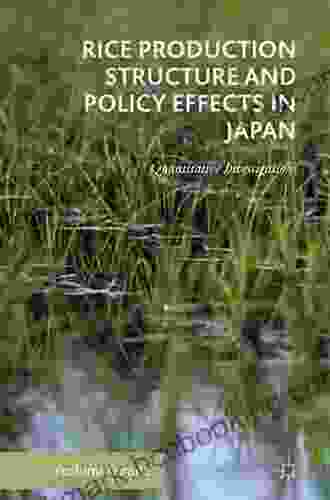Unlocking the Secrets of Japanese Rice Production: A Comprehensive Analysis of Structure and Policy Effects

4.8 out of 5
| Language | : | English |
| File size | : | 4024 KB |
| Text-to-Speech | : | Enabled |
| Screen Reader | : | Supported |
| Enhanced typesetting | : | Enabled |
| Word Wise | : | Enabled |
| Print length | : | 239 pages |
Rice, the staple food of Japan for centuries, holds a profound cultural and economic significance in the country. The production of rice in Japan has undergone significant transformations over the years, shaped by a complex interplay of factors including technological advancements, government policies, and market dynamics.
The Structure of Rice Production in Japan
Japanese rice production is characterized by a highly fragmented industry with a large number of small-scale farmers. The average farm size is a mere 1.2 hectares, and over 80% of farms cultivate less than 2 hectares of rice. This fragmentation is largely due to the country's mountainous terrain and the inheritance laws that have historically divided landholdings among multiple heirs.
Rice cultivation in Japan is a labor-intensive process, requiring meticulous care and attention to detail. Farmers typically use high-yielding hybrid rice varieties and employ advanced irrigation and fertilization techniques to maximize yields. The use of machinery in rice production has increased in recent years, but many tasks, such as transplanting and harvesting, are still carried out manually.
The majority of rice produced in Japan is consumed domestically. The country has a high per capita rice consumption rate, and rice is an essential component of the traditional Japanese diet. In addition to domestic consumption, Japan also exports a small amount of rice to other countries, primarily in Asia.
Government Policies and Their Impact
The Japanese government has played a significant role in shaping the structure and dynamics of rice production in the country. Government policies have aimed to achieve several objectives, including:
- Ensuring food security
- Supporting rural communities
- Maintaining agricultural productivity
- Stabilizing rice prices
One of the most important government policies affecting rice production is the rice price support system. This system guarantees farmers a minimum price for their rice, which is significantly higher than the world market price. The rice price support system has been successful in stabilizing rice prices and ensuring a stable income for farmers. However, it has also led to high rice prices for consumers and has contributed to government budget deficits.
Other government policies that affect rice production include:
- Land use policies
- Agricultural subsidies
- Research and development programs
- Marketing and distribution regulations
These policies have had both positive and negative effects on rice production in Japan. They have helped to ensure food security and support rural communities, but they have also led to high rice prices and have discouraged structural changes in the industry.
Challenges and Opportunities
Rice production in Japan faces a number of challenges, including:
- An aging farming population
- Increasing labor costs
- Climate change
- Competition from imported rice
To address these challenges, the Japanese government and the rice industry are working to:
- Encourage young people to enter farming
- Increase productivity through technological advancements
- Adapt to climate change
- Promote the consumption of Japanese rice
There are also a number of opportunities for rice production in Japan, including:
- Growing demand for high-quality rice
- Increasing exports to other countries
- Developing new rice-based products
The future of rice production in Japan is uncertain, but the industry is well-positioned to address the challenges it faces and capitalize on the opportunities that lie ahead.
Rice production in Japan is a complex and fascinating subject that has been shaped by a unique combination of factors. The industry faces a number of challenges, but it also has a number of opportunities. The Japanese government and the rice industry are working together to address the challenges and capitalize on the opportunities, ensuring the future of rice production in Japan.
4.8 out of 5
| Language | : | English |
| File size | : | 4024 KB |
| Text-to-Speech | : | Enabled |
| Screen Reader | : | Supported |
| Enhanced typesetting | : | Enabled |
| Word Wise | : | Enabled |
| Print length | : | 239 pages |
Do you want to contribute by writing guest posts on this blog?
Please contact us and send us a resume of previous articles that you have written.
 Book
Book Novel
Novel Page
Page Chapter
Chapter Text
Text Story
Story Genre
Genre Reader
Reader Library
Library Paperback
Paperback E-book
E-book Magazine
Magazine Newspaper
Newspaper Paragraph
Paragraph Sentence
Sentence Bookmark
Bookmark Shelf
Shelf Glossary
Glossary Bibliography
Bibliography Foreword
Foreword Preface
Preface Synopsis
Synopsis Annotation
Annotation Footnote
Footnote Manuscript
Manuscript Scroll
Scroll Codex
Codex Tome
Tome Bestseller
Bestseller Classics
Classics Library card
Library card Narrative
Narrative Biography
Biography Autobiography
Autobiography Memoir
Memoir Reference
Reference Encyclopedia
Encyclopedia Jim Kristofic
Jim Kristofic Robert Estella
Robert Estella Peter Bodo
Peter Bodo Jesse Mccarthy
Jesse Mccarthy Jessie Singer
Jessie Singer Kenneth Gjesdal
Kenneth Gjesdal Jen Hansard
Jen Hansard Randy Christian
Randy Christian Slavka Bodic
Slavka Bodic Jeremie Kubicek
Jeremie Kubicek Jennifer Steil
Jennifer Steil Karl E Peace
Karl E Peace Phil Davies
Phil Davies Jerry Yarnell
Jerry Yarnell Sheera Frenkel
Sheera Frenkel Jessa Stone
Jessa Stone Jessica Minahan
Jessica Minahan Pascuala Herrera
Pascuala Herrera Jim Aylesworth
Jim Aylesworth Nadine Taylor
Nadine Taylor
Light bulbAdvertise smarter! Our strategic ad space ensures maximum exposure. Reserve your spot today!
 George MartinFollow ·11k
George MartinFollow ·11k William GoldingFollow ·14.5k
William GoldingFollow ·14.5k Evan SimmonsFollow ·10k
Evan SimmonsFollow ·10k Cameron ReedFollow ·11.6k
Cameron ReedFollow ·11.6k Jeff FosterFollow ·16.9k
Jeff FosterFollow ·16.9k Curtis StewartFollow ·2k
Curtis StewartFollow ·2k Darnell MitchellFollow ·11.2k
Darnell MitchellFollow ·11.2k Victor HugoFollow ·19k
Victor HugoFollow ·19k

 Patrick Rothfuss
Patrick RothfussGuide for Parents: Unlocking Your Child's Problem-Solving...
As a parent, you...

 Ignacio Hayes
Ignacio HayesThe Good Girls of Al Noor: A Gripping Tale of Hope and...
On March 15, 2019, a...

 Lee Simmons
Lee Simmons50 Games and Activities for All the Turkeys at Your...
Thanksgiving is a time for family, friends,...

 Sean Turner
Sean TurnerRewiring the World: From Edison to Google - The...
A Captivating...
4.8 out of 5
| Language | : | English |
| File size | : | 4024 KB |
| Text-to-Speech | : | Enabled |
| Screen Reader | : | Supported |
| Enhanced typesetting | : | Enabled |
| Word Wise | : | Enabled |
| Print length | : | 239 pages |
















